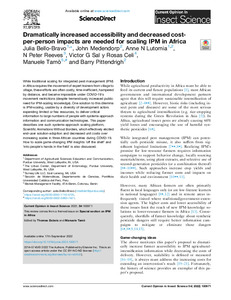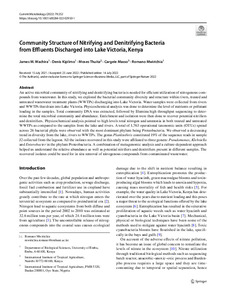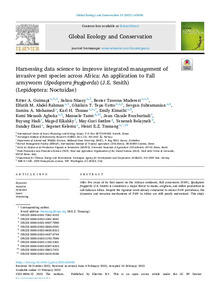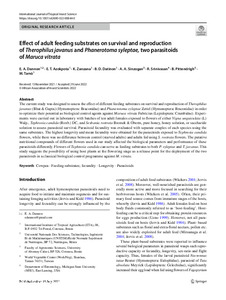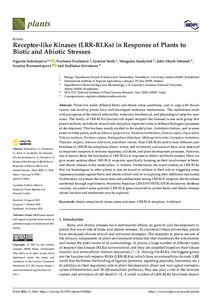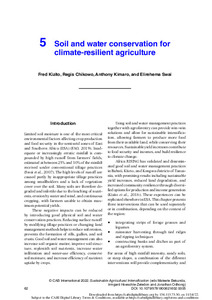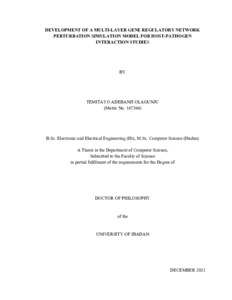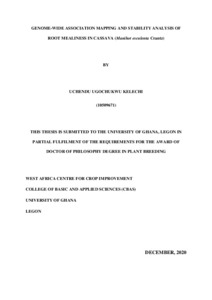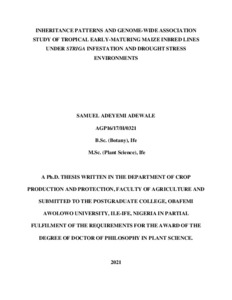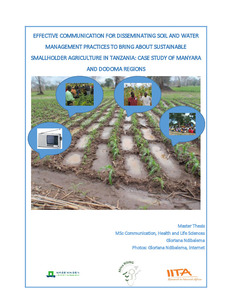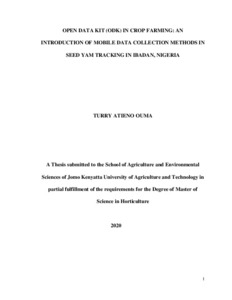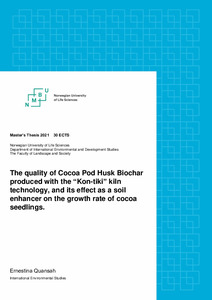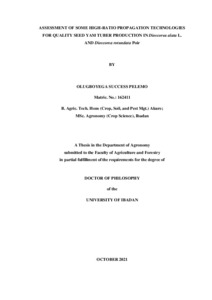Welcome to the International Institute of Tropical Agriculture Research Repository
IITA Bibliography System: Recent submissions
Now showing items 701-720 of 8099
-
Dramatically increased accessibility and decreased cost- per-person impacts are needed for scaling IPM in Africa
(2022-12)While traditional scaling for integrated pest management (IPM) in Africa requires the movement of expert trainers from village to village, these efforts are often costly, time-inefficient, hampered by distance, and became impossible under COVID-19's movement restrictions (despite tremendously increased public need for IPM-scaling knowledge). One solution to this dilemma is IPM-scaling, usable by a diversity of development actors expending limited or few resources, to deliver critical information ... -
Community structure of nitrifying and denitrifying bacteria from effluents discharged into Lake Victoria, Kenya
(2022)An active microbial community of nitrifying and denitrifying bacteria is needed for efficient utilization of nitrogenous compounds from wastewater. In this study, we explored the bacterial community diversity and structure within rivers, treated and untreated wastewater treatment plants (WWTPs) discharging into Lake Victoria. Water samples were collected from rivers and WWTPs that drain into Lake Victoria. Physicochemical analysis was done to determine the level of nutrients or pollutant loading ... -
Harnessing data science to improve integrated management of invasive pest species across Africa: An application to Fall armyworm (Spodoptera frugiperda) (J.E. Smith) (Lepidoptera: Noctuidae)
(2022-06)After five years of its first report on the African continent, Fall armyworm (FAW), Spodoptera frugiperda (J.E. Smith) is considered a major threat to maize, sorghum, and millet production in sub-Saharan Africa. Despite the rigorous work already conducted to reduce FAW prevalence, the dynamics and invasion mechanisms of FAW in Africa are still poorly understood. This study applied interdisciplinary tools, analytics, and algorithms on a FAW dataset with a spatial lens to provide insights and project ... -
Effect of adult feeding substrates on survival and reproduction of Therophilus javanus and Phanerotoma syleptae, two parasitoids of Maruca vitrata
(2022)The current study was designed to assess the effect of different feeding substrates on survival and reproduction of Therophilus javanus (Bhat & Gupta) (Hymenoptera: Braconidae) and Phanerotoma syleptae Zettel (Hymenoptera: Braconidae) in order to optimize their potential as biological control agents against Maruca vitrata Fabricius (Lepidoptera: Crambidae). Experiments were carried out in laboratory with batches of ten adult females exposed to flowers of either Vigna unguiculata (L) Walp., Tephrosia ... -
Assessing lethal doses of the baculovirus MaviMNPV and the effect of its combination with neem oil on the survival of Maruca vitrata (Fabricius) (Lepidoptera: Crambidae) larval stages in laboratory
(2022)Cowpea production is limited by predation from several insect pests, including Maruca vitrata (F.) (Lepidoptera: Crambidae) as one of the most destructive. The present study aimed to assess the pesticidal effect of neem oil and the baculovirus MaviMNPV (separately and in combination) on M. vitrata under laboratory conditions. Eight treatments in a 4-replicate randomized block design (including control) were assessed at each of the five M. vitrata larval stages. Neem oil induced larval mortality ... -
Banana mapping in heterogenous smallholder farming systems using high-resolution remote sensing imagery and machine learning models with implications for banana bunchy top disease surveillance
(2022)Banana (and plantain, Musa spp.), in sub-Saharan Africa (SSA), is predominantly grown as a mixed crop by smallholder farmers in backyards and small farmlands, typically ranging from 0.2 ha to 3 ha. The crop is affected by several pests and diseases, including the invasive banana bunchy top virus (BBTV, genus Babuvirus), which is emerging as a major threat to banana production in SSA. The BBTV outbreak in West Africa was first recorded in the Benin Republic in 2010 and has spread to the adjoining ... -
Receptor-like Kinases (LRR-RLKs) in response of plants to biotic and abiotic stresses
(2022)Plants live under different biotic and abiotic stress conditions, and, to cope with the adversity and severity, plants have well-developed resistance mechanisms. The mechanism starts with perception of the stimuli followed by molecular, biochemical, and physiological adaptive measures. The family of LRR-RLKs (leucine-rich repeat receptor-like kinases) is one such group that perceives biotic and abiotic stimuli and also plays important roles in different biological processes of development. This ... -
Soil and water conservation for climate-resilient agriculture
(CAB International, 2022-05)This chapter describes soil and water conservation measures for climate-resilient agriculture. It presents three interventions that can be used separately or in combination, depending on the context of the region: (1) integrating strips of forage grasses and legumes; (2) rainwater harvesting through tied ridges and ripping techniques; (3) constructing banks and ditches as part of an agroforestry system. The description of each technology, its benefits and application are discussed. -
A novel self-cleaving viroid-like RNA identified in RNA preparations from a citrus tree is not directly associated with the plant
(2022)Viroid and viroid-like satellite RNAs are infectious, circular, non-protein coding RNAs reported in plants only so far. Some viroids (family Avsunviroidae) and viroid-like satellite RNAs share self-cleaving activity mediated by hammerhead ribozymes (HHRzs) endowed in both RNA polarity strands. Using a homology-independent method based on the search for conserved structural motifs of HHRzs in reads and contigs from high-throughput sequenced RNAseq libraries, we identified a novel small (550 nt) ... -
Physicochemical parameters and functional properties of flours from advanced genotypes and improved cassava varieties for industrial applications
(University of Malawi, 2021-08)Cassava has potential for many industrial uses, which provide an opportunity for more rewarding markets. Therefore, significant research on improved varieties, targeting industrial applications, is required as a possible approach to spur improvements in the value chain. In addition, the promotion of cassava for production, targeting industrial applications, requires information on yield and stability performance of cassava genotypes and varieties in a diverse range of environments. To this end, ... -
Development of a multi-layer gene regulatory network perturbation simulation model for host-pathogen interaction studies
(University of Ibadan, 2021-12)Gene Regulatory Networks (GRNs) modulate the traits of an organism. Perturbation experiments which were employed to identify Trait-influencing Genes (TGs) are limited to only a few genes at once, and inadequate to identify the TGs of complex traits like disease resistance. Network modelling techniques for complex systems such as GRNs can provide a holistic system view to overcome the limitation of identifying TGs of complex traits with perturbation experiments when applied to genome-wide Next ... -
Genome-wide association mapping and stability analysis of root mealiness in cassava (Manihot esculenta Crantz)
(University of Ghana, 2020-12)Cassava breeders have made significant progress in developing new genotypes with improved agronomic characteristics such as improved root yield. However, these new and improved cassava genotypes in cultivation in Nigeria have undergone little or no improvement in their culinary qualities; hence, there is a paucity of information on the texture of boiled cassava roots, particularly with regard to its mealiness. The objectives of this study were to: (i) elicit farmers’ knowledge, perceptions and ... -
Effects of agroforestry and climate on cocoa yield, pests and diseases
(University of Ghana, 2021-06)Cocoa (Theobroma cacao) originates from the Amazon basin in South America. The crop is cultivated across many tropical regions, with the largest production from West Africa, where Ghana and Cote d’Ivoire contribute 70% of global production. Two major systems dominate cocoa production; a full-sun monocropping system where the cocoa crop is grown without shade trees, and an agroforestry system where cocoa is grown with deliberately planted or retained forest/fruit trees. Aside soil fertility and ... -
Rapid detection of adulterated fermented maize (Ogi) with sorghum leaf sheath (Poroporo) using visible-near infrared spectroscopy
(University of Ibadan, 2022-03)Food adulteration is a very old and common problem, which is often seen in both the low-and middle-income countries and even in some developed countries. Maize-based porridge especially ogi is a high-value commodity and common indigenous complementary food that is a target for adulteration, leading to loss of quality and encroachment on the rights and interests of consumers. This study investigated the characterization of the microorganisms found in ogi fermented for 0 to 120 hours and the feasibility ... -
Inheritance patterns and genome-wide association study of tropical early-maturing maize inbred lines under striga infestation and drought stress environments
(Obafemi Awolowo University, 2021)This study determined the gene action controlling grain yield and other agronomic traits among newly-developed early-maturing maize inbred lines under drought stress, Striga infestation, optimal conditions and across research environments; examined the combining ability of the early maize inbred lines under each and across research environments; classified the inbred lines into heterotic groups using DArTseq (Diversity Arrays Technology sequencing) markers and combining ability effects methods and ... -
Effective communication for disseminating soil and water management practices to bring about sustainable smallholder agriculture in Tanzania: case study of Manyara and Dodoma regions
(Wageningen University and Research Center, 2019-05)This study investigated effective communication for disseminating soil and water management (SWM) practices for sustainable smallholder agriculture. Higher uncertainties in precipitation and land degradation are potentially the most limiting reasons for poor performance of rainfed agricultural sectors in Tanzania. Despite the increased focus on sustainable intensification of African agriculture and an increase of agricultural innovations with potential to alleviate these, adoption by smallholder ... -
Title Open Data Kit (ODK) in crop farming: an introduction of mobile data collection methods in seed yam tracking in Ibadan, Nigeria
(2020)The purpose of this paper is to illustrate the importance of applying open-source technologies for mobile-based data collection for real-time tracking of seed yam (Dioscorea rotundata and Dioscorea alata) production. Seed yam data in Nigeria have been predominantly collected using field notebooks in the past, which were subsequently entered into a Microsoft Excel spreadsheet or Access database for analysis and reposition. Relevant areas of weakness within the current data systems include time delay ... -
The quality of Cocoa Pod Husk Biochar produced with the "Kon-tiki" kiln technology, and its effect as a soil enhancer on the growth rate of cocoa seedlings
(Norwagien University of Life Sciences, 2021)A study was conducted to investigate the potential of cocoa pod husk as feedstock for biochar production using the “Kon-tiki” kiln. The effect of cocoa pod husk biochar (CPHB) as a soil enhancer, was tested in particular with respect to the soil’s capacity to retain moisture and nutrients, and their consequences for the growth rate of cocoa seedling on two soil types. The resultant CPHB biochar was applied on two soil types from Ghana, Acherensua (sandy loam and near neutral) soil and Ayinase ... -
Assessment of some high ratio propagation technologies for quality seed yam tuber production in Dioscorea alata L. and Dioscorea rotundata Poir
(University of Ibadan, 2021-10)Edible yams are widely cultivated staple food crops in the tropics, but their production is constrained by low multiplication ratio, which results in short supply of Seed Yam Tubers (SYT). The use of High-ratio Propagation Technologies (HrPT) could enhance quality and quantity of SYT. However, limited information is available on the use of HrPT and the amenability of yam varieties to HrPT for SYT production. In this study, the uses of some HrPT for quality SYT production in Dioscorea alata and ... -
Morphological characterization of cacao cultivars in different socio-ecological settings of Ghana
(Georg-August-Universitat Gottingen, 2022-07-15)Knowledge of Theobroma cacao morphological variability provides the foundation for the utilization and conservation of genetic resources in Ghana. This study concentrated on cacao varieties, varietal richness and diversity maintained on farmers` fields. The objectives of the study were (1) to assess varietal richness per farm and the level of homozygosity of cacao cultivars on farmers’ fields through morphological analysis and farm management. (2) To identify existing cacao cultivars in the ...

